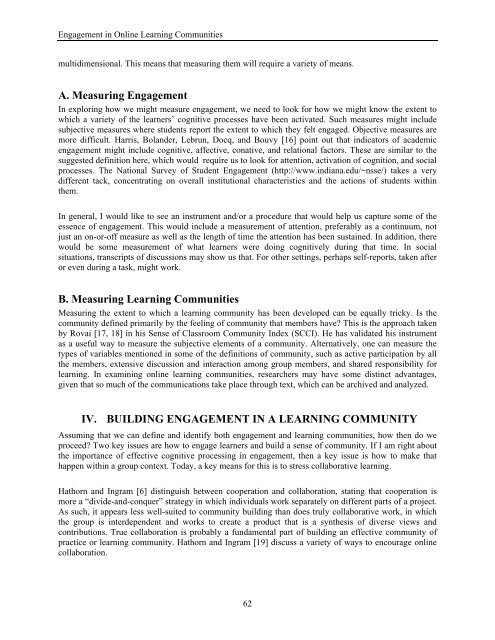Elements of Quality Online Education cation
Elements of Quality Online Education cation
Elements of Quality Online Education cation
Create successful ePaper yourself
Turn your PDF publications into a flip-book with our unique Google optimized e-Paper software.
Engagement in <strong>Online</strong> Learning Communitiesmultidimensional. This means that measuring them will require a variety <strong>of</strong> means.A. Measuring EngagementIn exploring how we might measure engagement, we need to look for how we might know the extent towhich a variety <strong>of</strong> the learners’ cognitive processes have been activated. Such measures might includesubjective measures where students report the extent to which they felt engaged. Objective measures aremore difficult. Harris, Bolander, Lebrun, Docq, and Bouvy [16] point out that indicators <strong>of</strong> academicengagement might include cognitive, affective, conative, and relational factors. These are similar to thesuggested definition here, which would require us to look for attention, activation <strong>of</strong> cognition, and socialprocesses. The National Survey <strong>of</strong> Student Engagement (http://www.indiana.edu/~nsse/) takes a verydifferent tack, concentrating on overall institutional characteristics and the actions <strong>of</strong> students withinthem.In general, I would like to see an instrument and/or a procedure that would help us capture some <strong>of</strong> theessence <strong>of</strong> engagement. This would include a measurement <strong>of</strong> attention, preferably as a continuum, notjust an on-or-<strong>of</strong>f measure as well as the length <strong>of</strong> time the attention has been sustained. In addition, therewould be some measurement <strong>of</strong> what learners were doing cognitively during that time. In socialsituations, transcripts <strong>of</strong> discussions may show us that. For other settings, perhaps self-reports, taken afteror even during a task, might work.B. Measuring Learning CommunitiesMeasuring the extent to which a learning community has been developed can be equally tricky. Is thecommunity defined primarily by the feeling <strong>of</strong> community that members have? This is the approach takenby Rovai [17, 18] in his Sense <strong>of</strong> Classroom Community Index (SCCI). He has validated his instrumentas a useful way to measure the subjective elements <strong>of</strong> a community. Alternatively, one can measure thetypes <strong>of</strong> variables mentioned in some <strong>of</strong> the definitions <strong>of</strong> community, such as active participation by allthe members, extensive discussion and interaction among group members, and shared responsibility forlearning. In examining online learning communities, researchers may have some distinct advantages,given that so much <strong>of</strong> the communi<strong>cation</strong>s take place through text, which can be archived and analyzed.IV. BUILDING ENGAGEMENT IN A LEARNING COMMUNITYAssuming that we can define and identify both engagement and learning communities, how then do weproceed? Two key issues are how to engage learners and build a sense <strong>of</strong> community. If I am right aboutthe importance <strong>of</strong> effective cognitive processing in engagement, then a key issue is how to make thathappen within a group context. Today, a key means for this is to stress collaborative learning.Hathorn and Ingram [6] distinguish between cooperation and collaboration, stating that cooperation ismore a “divide-and-conquer” strategy in which individuals work separately on different parts <strong>of</strong> a project.As such, it appears less well-suited to community building than does truly collaborative work, in whichthe group is interdependent and works to create a product that is a synthesis <strong>of</strong> diverse views andcontributions. True collaboration is probably a fundamental part <strong>of</strong> building an effective community <strong>of</strong>practice or learning community. Hathorn and Ingram [19] discuss a variety <strong>of</strong> ways to encourage onlinecollaboration.62
















